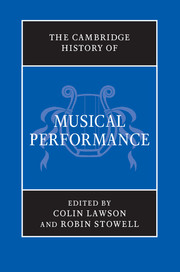Book contents
- Frontmatter
- PART I PERFORMANCE THROUGH HISTORY
- 1 Performance today
- 2 Political process, social structure and musical performance in Europe since 1450
- 3 The evidence
- 4 The performer and the composer
- 5 The teaching of performance
- 6 Music and musical performance: histories in disjunction?
- PART II PRE-RENAISSANCE PERFORMANCE
- PART III PERFORMANCE IN THE RENAISSANCE (C. 1430–1600)
- PART IV PERFORMANCE IN THE SEVENTEENTH CENTURY
- PART V PERFORMANCE IN THE ‘LONG EIGHTEENTH CENTURY’
- PART VI PERFORMANCE IN THE NINETEENTH CENTURY
- PART VII THE TWENTIETH CENTURY AND BEYOND
- PART VIII
- Index
4 - The performer and the composer
from PART I - PERFORMANCE THROUGH HISTORY
Published online by Cambridge University Press: 28 March 2012
- Frontmatter
- PART I PERFORMANCE THROUGH HISTORY
- 1 Performance today
- 2 Political process, social structure and musical performance in Europe since 1450
- 3 The evidence
- 4 The performer and the composer
- 5 The teaching of performance
- 6 Music and musical performance: histories in disjunction?
- PART II PRE-RENAISSANCE PERFORMANCE
- PART III PERFORMANCE IN THE RENAISSANCE (C. 1430–1600)
- PART IV PERFORMANCE IN THE SEVENTEENTH CENTURY
- PART V PERFORMANCE IN THE ‘LONG EIGHTEENTH CENTURY’
- PART VI PERFORMANCE IN THE NINETEENTH CENTURY
- PART VII THE TWENTIETH CENTURY AND BEYOND
- PART VIII
- Index
Summary
His execution is not polished – that is, his playing is not unblemished . . . his improvising gave me much pleasure . . . sometimes he does astonishing things. Besides, he ought not be thought of as a pianist, because he is dedicated totally to composition and it is very hard to be at once a composer and a performer.
This remarkable observation would have astonished earlier generations of musicians. In all likelihood it would have astonished Beethoven and most of his contemporaries as well. The idea that a composer could not be equally skilled as a performer was at the beginning of the nineteenth century revolutionary. Pleyel's comment, however, is representative of a shift of perspective in many aesthetic considerations during this period. It signals the beginnings of a century-long transition towards a separation of the roles of composers and performers, when the very nature of their relationship changed at a rate unprecedented in history.
This chapter will address this relationship by examining the perceived self-identity of composers and performers, the leadership of ensembles and the changing views regarding so-called ‘fidelity to the score’. It will also survey relevant performance issues which inform this relationship, such as improvisation, tempo and rubato, focusing on increased notational specificity introduced during the nineteenth century.
Communication and collaboration
The composer–performer relationship, at once both intimate and remote, is certainly among the most remarkable phenomena in Western music. Co-creators, like actor and playwright, choreographer and dancer, composer and performer have long collaborated fruitfully, but at the same time the relationship has been fraught with tension and potential misunderstandings.
- Type
- Chapter
- Information
- The Cambridge History of Musical Performance , pp. 105 - 134Publisher: Cambridge University PressPrint publication year: 2012
- 1
- Cited by



